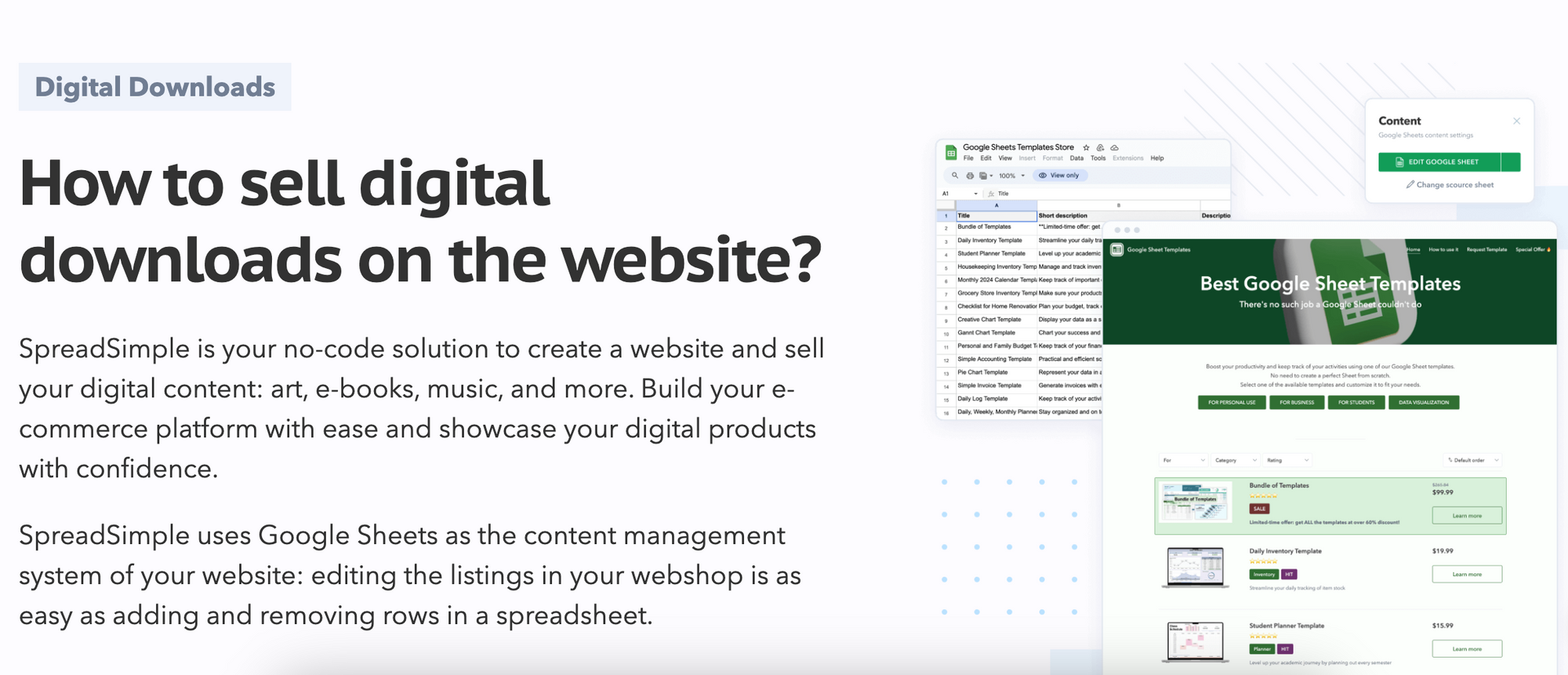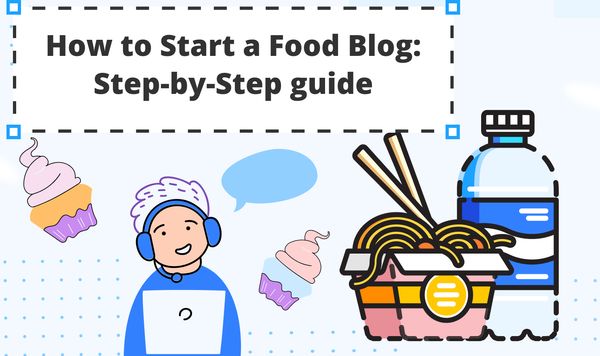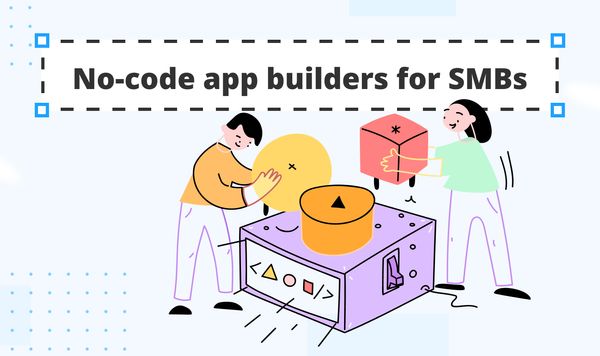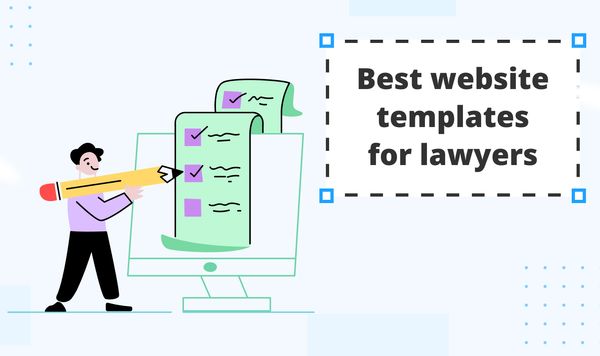How to sell digital downloads: a complete guide
Digital downloads are files that customers can purchase and download instantly, such as e-books, templates, music, courses, and design assets. Selling digital products can be highly profitable since there are no inventory costs, shipping fees, or production delays. Once created, a digital product can be sold repeatedly, making it a great source of passive income.
In this article, we’ll explain what digital products are, how they work, and why they’re a smart business choice. We’ll also walk you through the steps to start your own digital product shop from scratch, so you can launch and grow your online business with ease.
What are digital downloads?
Digital products, or digital downloads, are files, software, or content that people can buy and download. Unlike physical products, they do not require shipping, manufacturing, or storage. Once created, they can be sold an unlimited number of times without extra costs.
Digital products come in many forms. Some are purely informational, like ebooks and online courses. Others help people complete tasks more efficiently, like templates, calendars or graphic design assets. There are also digital products made for entertainment, such as music, movies, and stock footage.
One of the key advantages of digital products is that the distribution can be almost fully automated. Sales, payment processing, and delivery can all happen without your direct involvement. This makes them a great option for passive income.
Types of digital products
The digital product market is diverse, catering to different needs and industries. Here are some of the most popular categories:
- Ebooks: digital books covering fiction, non-fiction, guides, and how-tos.
- Templates: pre-designed resources like spreadsheets, presentations, CV templates, and more.
- Graphic designs: logos, icons, illustrations, and other design assets.
- Music: sound effects, beats, original compositions, and background music.
- Photos and art: stock images, digital paintings, and illustrations.
- Videos: tutorials, stock footage, and entertainment content.
- Printables: planners, calendars, worksheets, and journal pages.
- Courses and tutorials: educational content for skill development or professional training.
- Challenges: structured programs for fitness, productivity, or personal development.
- Planners and prepping guides: digital tools for organization, budgeting, or goal tracking.
Each category has different demand levels and competition. Choosing the right type of digital product depends on your expertise, audience, and market trends.
Overview of the digital product market
The demand for digital products has been rising steadily over the past decade. The growth of online education, remote work, and content creation has fueled the need for digital resources that help people work, learn, and create faster and more efficiently.
Many people now prefer digital solutions over traditional physical products. For example, ebooks have overtaken physical books in some markets, and online courses have replaced in-person workshops. Businesses also rely heavily on digital assets like stock images, video content, and design templates to streamline their operations.
People all over the world incorporate digital products into their everyday lives by using pre-designed meal planning calendars, budget planners, and other optimisation tools.
Today, it is really difficult to find a segment of audience that wouldn’t use at least some kind of digital product.
E-commerce platforms and marketplaces have played a huge role in making digital product sales accessible to individuals and small businesses. Instead of needing a custom-built website, creators can sell their digital products through platforms like Gumroad, Etsy, and Shopify. And for those who do want a custom website, SpreadSimple has made site creation as simple as possible. With the use of the AI creator and a library of templates, anyone can build a platform to distribute their digital products completely no-code. All this makes it easier than ever for anyone to turn their skills into a product.
However, the market is also becoming more competitive. Consumers expect high-quality content, seamless user experiences, and secure payment options. To stand out, digital product creators must focus on delivering real value and building a strong online presence.
Pros and cons of selling digital downloads
While selling digital products has many advantages, it also comes with challenges. Here’s a balanced look at both sides:
Benefits
- No production or shipping costs: once created, a digital product can be sold infinitely without extra expenses.
- High-profit margins: most of the revenue goes directly to the creator.
- Scalability: selling digital downloads doesn’t require handling inventory, making it easy to scale up.
- Global reach: digital products can be sold to customers anywhere in the world.
- Automation-friendly: sales, delivery, and customer support can be partially or fully automated.
- Flexibility: digital product creators can work from anywhere and set their own schedules.
Drawbacks
- High competition: many niches are saturated, making it hard to stand out.
- Piracy risks: digital files can be copied and shared illegally.
- Technical challenges: setting up payment processing, delivery automation, and security can be complex.
- Marketing is essential: without proper promotion, even high-quality digital products may not sell well.
- Frequent updates needed: many digital products require regular updates to stay relevant.
Despite the challenges, selling digital products remains one of the best ways to earn passive income and build an online business. The key to success is creating valuable content that meets a specific need, marketing it effectively, and optimizing the customer experience.
How does selling digital downloads work?
Selling digital downloads is a straightforward process that allows you to reach customers all over the world with ease:
- Creating the product.
- Selecting a platform to distribute your product.
- Setting up your shop on that platform or creating your own website.
- Setting up payment.
- Marketing through multiple channels.
- Scaling and enjoying passive income.
We'll walk through these steps in a bit. First, let's take a look at some real cases of people selling digital downloads.
Examples of selling digital downloads
Selling digital downloads opens up a world of possibilities for creators across various fields. Here are some inspiring examples to illustrate how you can turn your digital products into a successful business.
Selling an e-book on a marketplace
Selling podcasts on a website
Selling guides on a personal travel blog
Steps to successfully sell digital downloads
Now, let's go through each step of the process of creating and distributing your digital downloads. Ideally, if you prepare well and thoughtfully set up your shop, it could become a good source of passive income that won't require a lot of atention from you.
Step 1: Research and create your digital product
If you already have a digital product, the following tips might still be helpful to you — it’s always a good idea to do fresh research on your audience and adjust your product and marketing strategy accordingly.
Choose your niche and product
The first step is selecting a product that aligns with your expertise and interests. A successful digital product is one that not only excites you but also solves a real problem for your audience. Start by asking yourself: What do people frequently ask you for help with? What skills or knowledge do you have that others struggle with?
Once you have an idea, validate it through research. Look at best-selling products in your niche on platforms like Etsy, Gumroad, or Udemy. Read customer reviews to uncover common complaints and areas for improvement. Use keyword research tools to analyze search demand. A strong niche has both high demand and gaps you can fill with a better or unique product.
Understand your target audience
Your success depends on how well you understand your buyers. Instead of guessing, gather data using Google Analytics, Facebook Audience Insights, and competitor research. Define your audience based on key factors like age, interests, income level, and pain points.
Go beyond demographics — understand their motivations. Why would someone buy your product? Are they looking for a faster workflow, a professional result, or a way to earn money? Engaging with potential buyers on forums, Reddit, or social media groups can reveal insights that generic analytics might miss.
Create high-quality digital products
Digital products must be polished and valuable to stand out. A poor-quality product can damage your reputation and lead to refunds. Here are some examples on how you can polish your final product, depending on its type:
- Ebooks – ensure correct formatting, professional design, and easy readability. Break up long sections with visuals or examples.
- Templates – make them customizable and user-friendly. Provide clear instructions for use.
- Graphic design assets – deliver in multiple file formats (e.g., PNG, SVG, PSD) to maximize compatibility.
- Online courses – invest in good video and audio quality. Plan content structure carefully to keep learners engaged.
Use industry-standard tools like Adobe Suite, Canva, Scrivener, or Camtasia to maintain high production value. Consider beta-testing your product with a small audience before launch to refine and improve it.
Step2: Select the Right Selling Platform
Selling digital downloads requires a reliable e-commerce platform. The platform determines sales, pricing, and marketing strategies. So choosing the right outlet for your digital downloads will impact store management, the ways to reach your target audience, and transactions. Some platforms offer complete control, while others provide built-in customer bases and marketing tools.
Own website
Selling digital products through your own website gives full control over pricing, branding, and marketing strategies. It allows direct interaction with the target audience and avoids marketplace fees. However, running your own website requires effort in setting up and maintaining the store, as well as handling marketing and customer support.
SpreadSimple — the easiest choice for selling digital downloads independently
Website creation is often expected to be time-consuming, difficult and expensive—and in many cases it is, unless you are using a no-code solution that allows to significantly accelerate the process.
SpreadSimple is a no-code tool that turns Google Sheets into an online store. It is ideal for selling digital products. With SpreadSimple, you can easily manage inventory, pricing, and transactions in a simple spreadsheet while maintaining full control over your branding.

SpreadSimple features a special template for a digital downloads store — you can use it to kickstart your project. Alternatively, you can use the AI Creator to build the website from a quick prompt and then customize it and quickly fill in with your content.
Key benefits:
- Easy setup: no coding skills needed, making it accessible to beginners.
- Automated inventory: Simply update your Google Sheet, and your store updates automatically.
- Flexible pricing: Set and adjust pricing for digital products quickly without hassle.
- Custom branding: Modify design elements to match your brand’s identity.
- Payment systems: Integrate with Stripe, PayPal, or other payment gateways for smooth transactions.
- SEO-friendly: Optimized for search engines, increasing visibility to potential customers.
- No platform fees: Unlike marketplaces, you keep all your profits.
Other no-code solutions. There are alternative no-code solutions, such as Shopify and Wix. They do provide wider customisation options, but they also are more pricy and complex.
Pros and cons of selling digital downloads on your own website
Pros:
- No marketplace fees, meaning you keep 100% of your sales revenue.
- Full pricing control, allowing you to set competitive or premium pricing.
- Direct customer relationships, helping you build a loyal audience.
- Full customization, ensuring your website aligns with your brand identity.
- SEO benefits, allowing your store to rank on search engines and attract organic traffic.
Cons:
- Requires marketing efforts to drive traffic and generate sales.
- Setup and maintenance costs, including hosting, domain, and security.
- Customer support responsibilities, requiring time and effort to manage inquiries and issues.
Marketplaces
Selling on digital marketplaces provides access to large audiences. These platforms handle payment processing and customer traffic but take a percentage of each sale. They are ideal for sellers who want a ready-made audience without investing heavily in marketing.
Amazon
Amazon allows selling digital downloads like eBooks, software, and music. It is one of the largest marketplaces, offering massive exposure to potential buyers.
Pros:
- Large customer base with global reach.
- Trusted platform that buyers feel comfortable purchasing from.
- Integrated payment processing and delivery.
Cons:
- High competition makes it challenging to stand out.
- Platform fees reduce overall profit margins.
- Limited branding opportunities since customers associate products with Amazon rather than the seller.
Etsy
Etsy is great for digital designs, printables, and templates. It attracts a niche audience looking for creative products.
Pros:
- Niche audience specifically searching for unique digital products.
- Easy setup with minimal technical requirements.
- Built-in traffic reduces the need for external marketing.
Cons:
- Listing fees and transaction fees eat into profits.
- Limited branding control compared to an independent store.
- Market saturation in some product categories.
Creative Market
Creative Market specializes in digital products like fonts, graphics, and templates. It is popular among designers and creative professionals.
Pros:
- Design-focused audience, making it ideal for creative assets.
- Exposure to professionals looking for high-quality digital goods.
- Less need for personal marketing since buyers actively search the marketplace.
Cons:
- Revenue sharing means you earn less per sale.
- High competition from established sellers.
- Strict quality control requirements for listing products.
Pros and cons of selling digital downloads on marketplaces
Pros:
- Instant audience access without extensive marketing.
- Less need for personal promotion since the platform attracts buyers.
- Secure transactions and automated delivery for customer convenience.
- Built-in trust, as marketplaces handle disputes and customer service.
Cons:
- Fees per sale can significantly reduce profits.
- Limited control over branding, pricing, and customer communication.
- Marketplace algorithm changes can affect product visibility.
Social media's built-in tools for e-commerce
Social media platforms now support direct selling. Businesses can sell digital downloads on Instagram, Facebook, and TikTok. These platforms allow sellers to engage directly with their audience and market their products organically.
Instagram and Facebook Shops
These platforms allow selling digital products through integrated shopping features. Business owners can showcase their products through posts, stories, and ads, driving direct sales.
Pros:
- Large audience reach through organic and paid promotions.
- Direct engagement with buyers through comments, DMs, and live sessions.
- Free store setup with access to Facebook’s and Instagram’s large user bases.
Cons:
- Requires social media marketing to drive visibility.
- Payment systems vary by region, limiting accessibility.
- Algorithm changes may affect reach and engagement.
TikTok Shop
TikTok offers built-in e-commerce features, allowing sellers to showcase products through video content. Viral marketing can help digital products gain massive exposure in a short time.
Pros:
- High engagement potential with a younger audience.
- Suitable for viral marketing strategies.
- Integration with influencers for promotional campaigns.
Cons:
- Not all regions support digital product sales.
- Requires consistent content creation to stay relevant.
- Success depends on the algorithm, making reach unpredictable.
Pros and cons of selling digital downloads directly through social media
Pros:
- Free to list products without marketplace fees.
- Direct customer engagement builds stronger relationships.
- No need for a separate online store, reducing setup costs.
- Leverages social proof, as followers can share and promote products.
Cons:
- Requires active marketing and regular content posting.
- Payment and delivery depend on platform policies and limitations.
- Customer trust may be lower compared to established e-commerce platforms.
Step 3: Set up your online store
Customize your storefront to reflect your brand by choosing a cohesive color scheme, fonts, and a logo. A clear and intuitive layout improves user experience and increases conversions. Ensure straightforward navigation by minimizing the number of clicks required to reach product pages and checkout.
Use high-quality visuals, such as product mockups and preview images, to create a professional appearance. If applicable, include video demonstrations showcasing the digital product in use. An engaging storefront increases customer trust and reduces hesitation in purchasing.
Pro tip. Include case studies and show how your product helps improve the lives of your clients. For example, if you selling meal prepping planners, you can count how much time your clients save per week using your product. Post real testimonials and real use cases of your products.
Step 4: Price your digital products strategically
Pricing your digital products requires a strategic approach. Consider both the value your product provides and the willingness of your target audience to pay. Instead of arbitrarily selecting a price, conduct competitor analysis to see how similar products are priced and assess market standards.
Understand pricing psychology. Using charm pricing (e.g., $19.99 instead of $20) can increase conversions. Alternatively, premium pricing can signal higher value, especially for niche or highly specialized products.
Offer tiered pricing or product bundles to provide flexible options. For example, if you sell digital courses, offer different levels of access (basic, premium, and VIP) to cater to different budgets and needs. Consider offering limited-time discounts or early-bird pricing to encourage initial sales and validate pricing.
Step 5: Craft compelling product listings
Your product listing should be designed to convert visitors into buyers. Start with clear, keyword-rich titles that are optimized for search engines. Ensure that titles highlight the key benefit or unique selling point of the digital product.
Write a compelling description that outlines the main features and benefits. Instead of just listing features, explain how they solve a problem or add value. Use bullet points to make the information easy to scan.
High-quality images and sample previews help customers understand what they are buying. If applicable, provide a free sample or demo version to build trust. If selling an ebook, offer a downloadable sample chapter; if selling a design template, provide a preview file.
Consider adding testimonials or user-generated content to your product page to establish credibility and encourage conversions. Social proof can significantly increase trust in digital products.
Step 6: Implement payment and delivery systems
Choosing the right payment system is crucial to ensuring a smooth checkout process. Select secure and reliable payment gateways such as PayPal, Stripe, or Square. Ensure that your platform supports multiple payment methods, including credit cards, debit cards, and digital wallets like Apple Pay or Google Pay.
For digital product delivery, automation is key. Use tools like SendOwl, Gumroad, or FetchApp to automatically deliver files upon purchase. This prevents manual intervention and ensures instant access for buyers. Consider implementing PDF stamping or licensing systems if your product requires additional security.
Additionally, provide a clear refund policy to manage customer expectations. Some platforms allow limited refunds for digital products, while others enforce strict no-refund policies. Make sure to clearly communicate your policy on your store.
Step 7: Develop a marketing strategy
Marketing is essential for driving traffic and increasing sales. Utilize multiple channels to reach your audience, including social media, email marketing, and SEO strategies.
Leverage content marketing by creating blog posts, videos, or tutorials that showcase how your digital product can be used. Optimize your content with relevant keywords to improve search engine visibility. For example, if you sell digital planners, write blog posts about productivity tips and include links to your products.
Use paid advertising strategically. Platforms like Facebook Ads, Google Ads, and Pinterest Ads can help you target specific audiences who are most likely to be interested in your product. Run retargeting campaigns to reach visitors who have previously viewed your product but didn’t complete a purchase.
Engage with your community through email marketing. Build an email list by offering a free lead magnet, such as a free guide or template, in exchange for an email subscription. Nurture your subscribers with valuable content and occasional promotional offers.
Step 8: Monitor sales and gather feedback
Tracking performance is essential for improving your sales strategy. Use analytics tools like Google Analytics, Shopify Analytics, or your e-commerce platform’s reporting features to monitor sales trends and identify which products perform best.
Collect feedback through surveys, reviews, or direct customer interactions. Understanding why customers buy—or why they don’t—can provide valuable insights for optimizing product offerings. If you notice high cart abandonment rates, assess whether the checkout process needs improvement.
Use A/B testing to refine pricing, product descriptions, and marketing strategies. Experiment with different images, calls to action, and layouts to determine what resonates most with your audience.
Top tips for selling digital downloads
- Know your customers: understand their pain points and motivations.
- Choose the right marketing channels: focus on platforms where your audience spends time.
- Turn followers into subscribers: build an email list for long-term customer engagement.
- Leverage social proof: use customer testimonials and case studies to build credibility.
- Continuously update and improve products: provide updates or new versions to maintain customer interest.

Frequently asked questions
1. What are the best platforms to sell digital downloads?
If you want to build your own website and sell your products independently, then SpreadSimple is the easiest way to go. This tool allows you to build a website in minutes, using AI and then manage it throug Google Sheets.
Platforms like Shopify, WooCommerce, Gumroad, and Sellfy support selling digital products. Consider factors like pricing, automation features, and customization options when choosing a platform.
2. How do I price my digital products?
Research competitors, consider the perceived value, and test different pricing strategies. Tiered pricing and limited-time discounts can help maximize revenue.
3. What payment methods should I offer?
Popular options include PayPal, Stripe, and credit card payments. Providing multiple payment options increases conversion rates.
4. How do I deliver digital products?
Use automated delivery tools like SendOwl, Gumroad, or FetchApp to provide instant file access. Consider adding licensing or watermarking for additional security.
5. How can I attract more buyers?
Utilize SEO, social media marketing, and email campaigns to drive traffic. Create valuable content related to your digital products to attract organic visitors.
6. How to sell digital downloads on Etsy
To sell digital downloads on Etsy, start by creating an Etsy shop and selecting "digital products" as your category. Upload high-quality digital files, such as PDFs, PNGs, or ZIP files, and provide detailed descriptions with relevant keywords. Ensure that your files meet Etsy’s size and format requirements to avoid any issues during the upload process.
Next, optimize your product listings with clear titles, descriptions, and tags to improve search visibility. Use high-quality preview images to showcase your digital products. Competitive pricing and well-structured product descriptions help attract buyers. Consider offering bundles or discounts to increase sales volume.
After setting up your shop, promote your digital downloads through social media, Pinterest, and Etsy Ads. Engage with customers by responding to inquiries quickly and providing excellent customer support. Since digital downloads are delivered automatically, ensure that buyers receive the correct files and offer assistance if needed.
7. How to sell digital downloads on Amazon
Selling digital downloads on Amazon depends on the type of product you offer. If you’re selling eBooks, you need to publish them through Kindle Direct Publishing (KDP). Create an account, format your book properly, and set your pricing strategy. Amazon offers options for royalties and promotions through Kindle Unlimited and Kindle Select.
For other digital products, such as software, music, or design assets, you can sell through Amazon’s Digital Services or Amazon Merch. Ensure your product complies with Amazon’s guidelines and upload it in the correct format. Provide a clear product description, high-quality images, and competitive pricing to attract buyers.
Marketing your digital downloads on Amazon involves optimizing your listings with keywords, utilizing Amazon Ads, and encouraging customer reviews. Keep an eye on pricing trends and competitor strategies to stay competitive. Monitor customer feedback and update your product listings to improve visibility and sales over time.


